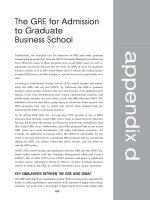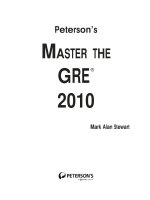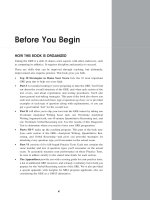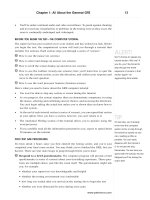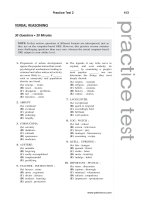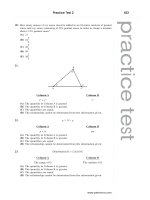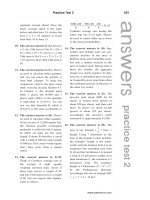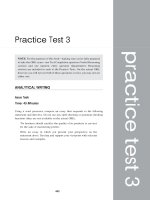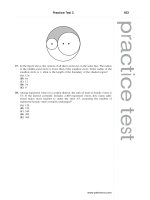Tài liệu Master the Gre 2010 - Part 6 pptx
Bạn đang xem bản rút gọn của tài liệu. Xem và tải ngay bản đầy đủ của tài liệu tại đây (80.73 KB, 10 trang )
GRE Questions—A First
Look
OVERVIEW
• The GRE’s eight basic question formats
• The Analytical Writing section
• The Quantitative Reasoning section
• The Verbal Reasoning section
• Summing it up
In Chapter 1, you learned about the overall structure of the GRE. In this
chapter, you’ll delve deeper into the test by exploring the various formats for
GRE test questions.
THE GRE’S EIGHT BASIC QUESTION FORMATS
The GRE employs eight distinct question formats altogether. Here’s how they’re
grouped among the test’s three different sections:
Analytical Writing Section
Issue Task (1 essay)
Argument Task (1 essay)
Quantitative Reasoning Section
Quantitative Comparison (14 questions)
Problem Solving (14 questions)
Verbal Reasoning Section
Sentence and Text Completions (6 questions)
Reading Comprehension (8 questions, 2–4 sets)
Analogies (9 questions)
Antonyms (7 questions)
In the pages ahead, you’ll explore each format, in the sequence listed above.
You’ll learn how each format measures a distinct set of cognitive abilities, and
you’ll examine each one’s unique set of test directions. For each format, you’ll
also look at one or two illustrative questions.
THE ANALYTICAL WRITING SECTION
The 75-minute Analytical Writing section consists of two separate timed
writing tasks: an Issue task (Present Your Perspective on an Issue) and an
chapter2
....................................................................................
33
Argument task (Argument Analysis). These two writing tasks have a lot in common.
For each one:
• You compose an essay response using the built-in word processor.
• You respond to an essay topic, or “prompt,” that the computerized test presents to
you. (For the Issue task, you choose between two prompts.)
• Your essay will be evaluated based on four broad areas: content, organization,
writing style, and mechanics (grammar, syntax, word usage, and so on).
The Issue Task (45 Minutes)
This 45-minute writing task tests your ability to present a position on an issue
effectively and persuasively. Your task is to compose an essay in which you respond to
a brief (one- or two-sentence) opinion about an issue of general intellectual interest.
More specifically, your job is to consider various perspectives, take a position on the
issue, and argue for that position.
Your Issue essay will be evaluated based on your proficiency areas:
recognizing and dealing with the complexities and implications of the issue
organizing, developing, and expressing your ideas
supporting your ideas with reasons and examples
controlling the elements of Standard Written English
Your Issue topic will consist of a statement of opinion, which appears in quotes,
accompanied by a brief directive (statement of your task). Here’s an example:
“People often complain that the introduction of new labor-saving machines costs
workers their jobs. However, most new technologies create more jobs than they
destroy.”
In your view, how accurate is the foregoing statement? Develop and support your
viewpoint with relevant reasons and examples and by considering ways in which
the statement may or may not be true.
The test will present two Issue topics, and you must select either one for your writing
task. Your Issue topic might involve virtually any area of mainstream intellectual
inquiry. Here are some of the possible themes for an Issue topic:
• Conformity and tradition vs. individuality and innovation
• Practicality and utility vs. creativity and personal enrichment
• The importance of cultural identity (customs, rituals, and ideals)
• Keys to individual success and progress
• Keys to societal progress and how we define it
• How we obtain or advance knowledge and what constitutes knowledge or
advancement of knowledge
• The objectives and methods of formal education
• The value of studying history
PART I: GRE Basics34
.................................................................
..............................................................................................
www.petersons.com
• The impact of technology on society and on individuals
• The type of people society considers heroes or great leaders
• The function and value of art and science (for individuals and for society)
• The proper role of government, business, and individuals in ensuring the well-
being of society
KEY FACTS ABOUT GRE ISSUE ESSAYS
• There is no “correct” answer for the Issue essay. What’s important is not what
your specific position is, but how effectively you present and support that
position.
• The Issue task is not intended to test your knowledge of any topic. Of course,
you’ll need to be somewhat familiar with the topic at hand, but don’t worry if
you’re not an expert on the subject. This part of the test is designed mainly to
determine your ability to assemble a well-organized and cohesive essay.
• GRE readers understand your time constraint, so they’ll focus mainly on the
substance and organization of your essay. Writing style and mechanics (grammar,
syntax, word usage, and so on) come into play only if problems in these areas
interfere with the reader’s understanding of the ideas you’re intending to convey
in your essay. You won’t be penalized for errors in spelling and punctuation unless
the errors are frequent and egregious.
The Argument Task (30 Minutes)
The Argument writing task is designed to test your critical reasoning and analytical
writing skills. Your job is to compose an essay in which you critique a paragraph-
length argument containing a series of premises and a conclusion. You must critique
the argument’s unstated assumptions, its logic (line of reasoning), or both. You might
also indicate how the argument could be improved or what additional information
might help you to evaluate it.
Your Argument essay will be evaluated based on the following four proficiency areas:
identifying and analyzing the key elements of the argument
organizing, developing, and expressing your critique
supporting your ideas with reasons and examples
controlling the elements of Standard Written English
Your essay prompt will consist of a quoted argument, accompanied by a directive
(statement of your task). The prompt might also indicate the source of the fictitious
quote. Here’s an example:
Chapter 2: GRE Questions—A First Look 35
.................................................................
..............................................................................................
NOTE
The GRE word processor does
not include a grammar
checker or spell checker. For
more details about the exam’s
word processing features, see
Chapter 1.
www.petersons.com
The following recommendation appeared in a memo from the Hillsville City
Council to the city’s mayor:
“The private firm Trashco provides refuse pickup and disposal as well as recy-
cling services for the town of Plattsburg. Trashco’s total fees for these services
are about two-thirds what Hillsville pays Ridco for the same services. In order to
save enough money to construct a refuse transfer station within our city limits,
Hillsville should discontinue using Ridco’s services and use Trashco’s services
instead.”
Discuss how well-reasoned you find this argument.
KEY FACTS ABOUT GRE ARGUMENT WRITING TASKS
• Regardless of the Argument at hand, the directive is always the same: Discuss
how well-reasoned you find the Argument.
• Unlike the Issue task, you won’t be able to choose between two Argument topics.
The test will present only one Argument to you.
• The Argument task is much different from the Issue task. An Issue prompt has no
“correct” answer—but with this essay, the argument that you critique will contain
at least three major problems in the use of evidence, reasoning, and/or logic. To
score high on this essay, you must identify and discuss each major problem
according to the specific directive.
• You don’t need technical knowledge or special training in logic to score high on
this essay. GRE Arguments are designed so that you can analyze them by
applying general reasoning skills and common sense.
• Just as with the Issue task, GRE readers understand that you’re under a time
constraint, so they won’t penalize you for occasional grammatical, spelling, or
punctuation gaffes.
THE QUANTITATIVE REASONING SECTION
The 45-minute Quantitative Reasoning section consists of 28 questions designed to
measure the following five skills:
your proficiency in arithmetical operations
your proficiency at solving algebraic equations and applying simple functions
your ability to convert verbal information into mathematical terms
your ability to visualize geometric shapes and numerical relationships
your ability to devise intuitive and unconventional solutions to conventional
mathematical problems
PART I: GRE Basics36
.................................................................
..............................................................................................
www.petersons.com
You will need to perform simple calculations to answer many of the questions. But you
won’t need to do a lot of number crunching, that’s not what you’re being tested on.
Here’s a breakdown of the specific areas on the Quantitative Reasoning section. The
number of questions indicated for each area is approximate.
Properties of Numbers and Arithmetical Operations (7–10 Questions):
• linear ordering (positive and negative numbers, absolute value)
• properties of integers (factors, multiples, prime numbers)
• arithmetical operations
• laws of arithmetic
• fractions, decimals, and percentages
• ratio and proportion
• exponents (powers) and roots
• descriptive statistics (mean, median, mode, range, standard deviation)
• basic probability, permutations, and combinations
Algebraic Equations and Inequalities (8–9 Questions):
• simplifying linear and quadratic algebraic expressions
• solving linear equations in one and two variables
• applying simple algebraic functions
• solving factorable quadratic equations
• solving inequalities
Geometry, Including Coordinate Geometry (526 Questions):
• intersecting lines and angles
• perpendicular and parallel lines
• triangles
• quadrilaterals (four-sided polygons)
• circles
• rectangular solids (three-dimensional figures)
• cylinders
• coordinate geometry
Interpretation of Statistical Data Presented in Graphical Form
(4–5 Questions):
• pie charts
• tables
• bar graphs
• line charts
• other types of graphical displays
Chapter 2: GRE Questions—A First Look 37
.................................................................
..............................................................................................
NOTE
The GRE does NOT provide an
on-screen calculator, and you
are NOT permitted to bring
any type of calculator into the
testing room.
NOTE
The algebraic concepts you’ll
see on the GRE are normally
covered in a first-year high
school algebra course. The
GRE does not cover more
advanced areas, such as
trigonometry and calculus.
www.petersons.com
